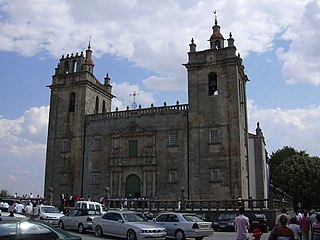
The Douro is one of the major rivers of the Iberian Peninsula, flowing from its source near Duruelo de la Sierra in Soria Province across northern-central Spain and Portugal to its outlet at Porto.

Miranda do Douro or Miranda de l Douro is a town and a municipality in the district of Bragança, northeastern Portugal. The population in 2011 was 7,482, in an area of 487.18 km². The town proper had a population of 1,960 in 2001. Referred to as the "Cidade Museu" of the Trás-os-Montes region, it is located 86 kilometres from Bragança, preserving many of its medieval and Renaissance-era traditions and architecture. It has a language of its own, Mirandese, which enjoys official status in Portugal, in addition to cultural and historical discontinuity with the rest of the Portuguese state. The town is located on the border with Spain, with the Douro River separating the two countries. The nearest town in Spain is Zamora.

Peso da Régua, commonly known as Régua, is a municipality in northern Portugal, in the district of Vila Real. The population in 2011 was 17,131, in an area of 94.86 km2 (36.63 sq mi) km².

The Comunidade Intermunicipal do Douro is an administrative division in Portugal. It replaced the Comunidade Urbana do Douro, created in 2004. It takes its name from the Douro River. The seat of the intermunicipal community is Vila Real. Douro comprises parts of the former districts of Bragança, Guarda, Vila Real and Viseu. The population in 2011 was 205,157, in an area of 4,031.58 km².

Vila Nova de Foz Côa is a city and a municipality in the district of Guarda, Portugal. The population in 2011 was 7,312, in an area of 398.15 square kilometres (153.73 sq mi). The city population is around 3,300. Main rivers in the municipal territory include the Douro and the Côa.

São João da Pesqueira is a municipality and municipal seat in the Portuguese district of Viseu. The population of the municipality in 2011 was approximately 7,874 inhabitants, in an area that extends 266.11 square kilometres (102.75 sq mi). The present mayor is Manuel Cordeiro, elected by a citizens' movevent. The municipal holiday is June 24.

Lordelo do Ouro is a former civil parish in the municipality of Porto, Portugal. In 2013, the parish merged into the new parish Lordelo do Ouro e Massarelos. The population in 2011 was 22,270, in an area of 3.64 km². It overlooks the Douro river.

Nevogilde is a former civil parish in the municipality of Porto, Portugal. In 2013, the parish merged into the new parish Aldoar, Foz do Douro e Nevogilde. The population in 2011 was 5,018, in an area of 1.84 km².

Raul Germano Brandão was a Portuguese writer, journalist and military officer, notable for the realism of his literary descriptions and by the lyricism of his language. Brandão was born in Foz do Douro, a parish of Porto, where he spent the majority of his youth. Born in a family of sailors, the ocean and the sailors are recurring themes in his work.

Festa de São João do Porto is a festival that happens every year during Midsummer, on the night of 23 June, in the city of Porto, in the north of Portugal, thousands of people come to the city centre and more traditional neighborhoods to pay a tribute to Saint John the Baptist, in a party that mixes sacred and profane traditions.

Canidelo is a Portuguese parish in the municipality of Vila Nova de Gaia. The population in 2011 was 27,769, in an area of 8.93 km². It is located along the mouth of Douro river and the Atlantic Ocean, across from Foz do Douro, Porto.

The term "provinces" has been used throughout history to identify regions of continental Portugal. Current legal subdivisions of Portugal do not coincide with the provinces, but several provinces, in their 19th- and 20th-century versions, still correspond to culturally relevant, strongly self-identifying categories. They include:

Matosinhos is a city and a municipality in the northern Porto district of Portugal, bordered in the south by the city of Porto. The population in 2011 was 175,478, and covered an area of approximately 62.42 square kilometres (24.10 sq mi). The urban centre, the city proper, had a population of 45,703 in 2001.

The Fountain of Passeio Alegre is a fountain located in civil parish of Aldoar, Foz do Douro e Nevogilde, municipality of Porto in northern Portugal.

Foz do Sousa e Covelo is a civil parish in the municipality of Gondomar, Portugal. It was formed in 2013 by the merger of the former parishes Foz do Sousa and Covelo. The population in 2011 was 7,701, in an area of 30.24 km².

The Lighthouse of São Miguel-o-Anjo is a former hermitage and 16th century lighthouse, in the civil parish of Aldoar, Foz do Douro e Nevogilde, municipality of Porto, in the Portuguese Norte Region. The lighthouse of São Miguel-o-Anjo is Portugal's oldest existing lighthouse and one of the oldest in Europe. Designed by Italian architect Francesco da Cremona, the project was completed in 1538.

The Sousa River is a river in Portugal, a tributary of the Douro. It rises in the parish of Friande, Felgueiras, in the Porto District of northwest Portugal, and is a right tributary of the Douro, which it meets at the parish of Foz do Sousa, Gondomar, about 16 km from the mouth of the Douro.



















